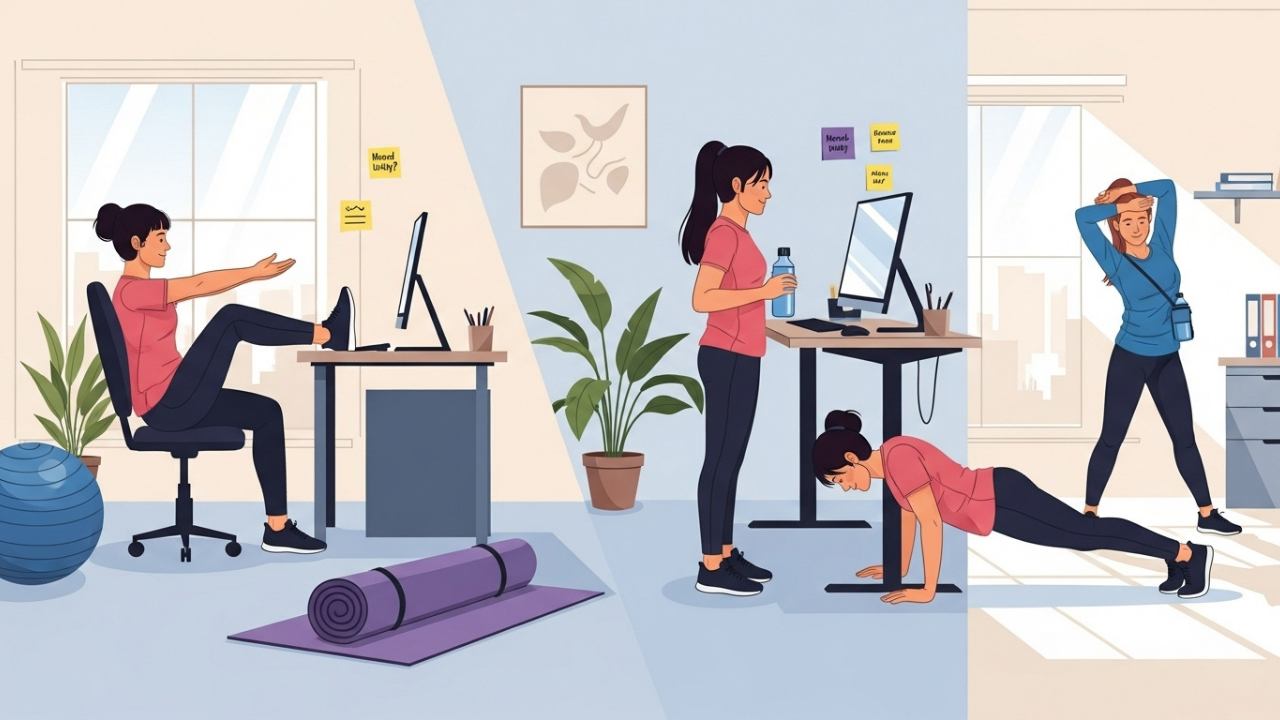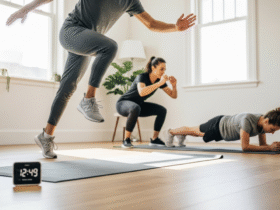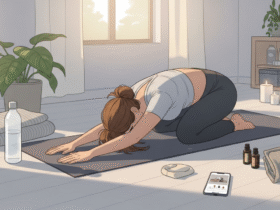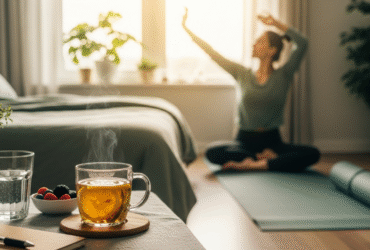Let’s be real — office work at a desk feels comfy. But after a while, you start wondering if you’re turning into part of the furniture.
You wake up, sit down for 8 to 10 hours, go home, eat, then flop on the sofa. Before you know it, the days all blend together, and you wonder why you’re feeling so sluggish and stiff.
You’re definitely not alone. Millions of people ask the same thing every day:
How do I stay active when I sit most of the day?
Good news — you don’t have to quit your job or sign up for an expensive gym membership to fix it.
With a few easy changes, you can break the cycle and build a more energized, mindful lifestyle — right from your office chair.
Why Sitting All Day Is a Silent Health Risk
At first glance, sitting seems harmless. But research tells a different story.
Sitting for long periods — especially without breaks — has been linked to:
-
Poor posture and back pain
-
Stiff neck and tight hips
-
Reduced blood flow, which ups your risk for blood clots
-
Higher chances of obesity, diabetes, and heart problems
-
Lower metabolism, energy crashes, and mental fog
These aren’t just little annoyances — this is what experts call “sitting disease.”
What is Sitting Disease?
It’s not just a catchy phrase — it’s real. It means the long-term damage caused by sitting too much.
Even hitting the gym on weekends doesn’t completely undo sitting all week.
But here’s the best part: you don’t have to overhaul your life overnight. Just adding regular, small movements during your workday can make a huge difference.
Set Movement Reminders: The Power of Mini-Breaks
One of the easiest, most effective tips? Break up your sitting.
Doctors recommend standing or moving every 30 to 60 minutes.
Try things like:
-
Getting up to refill your water bottle
-
Taking a quick walk around the office or your room
-
Doing a 2-minute stretch at your desk
-
Walking while on phone calls
Set reminders so you don’t forget: phone alarms, apps like Stand Up! or Stretchly, or even a sticky note on your monitor that says, “Moved lately?”
These little breaks help reduce stiffness, boost circulation, and keep your brain sharp. A quick stretch or walk is like a mini energy boost for your body and mind.
Try Office-Friendly Workouts Without Leaving Your Desk
No gym? No problem.
You can sneak in some gentle workouts without leaving your seat or needing special gear:
-
Seated Leg Lifts: Lift one leg straight out and hold for 5 seconds, then switch. Great for your core and circulation.
-
Calf Raises: Stand behind your chair, raise up on your toes, and lower. Do 10–15 reps to get blood flowing.
-
Chair Squats: Stand up and sit back down without using your hands. A few sets can strengthen legs and glutes.
-
Desk Push-ups: Use your desk for standing push-ups to work your arms and chest.
-
Neck and Shoulder Rolls: Roll your shoulders forward and backward to ease tension.
These are subtle, quiet, and easy to do multiple times a day. They add up more than you think.
Alternate Between Sitting and Standing (If You Can)
Sitting all day is unhealthy — but standing all day isn’t ideal either.
The real solution? Switch between sitting and standing throughout your workday.
If you have an adjustable or standing desk, use it to follow a ratio like:
🕒 30:1 — 30 minutes standing for every hour of sitting
(Or find a rhythm that works best for your body)
No standing desk? Try these DIY solutions:
- Stack books or boxes under your laptop
- Use a countertop or bar-height table for short tasks
- Pair a laptop stand with a wireless keyboard and mouse to create an upright workstation
This gentle switching reduces back pain, increases energy, and prevents your metabolism from stalling.
It’s not about standing for hours — it’s about movement variety.
Walk With Intention Even If It’s Just Down the Hall
Walking is often underestimated because it’s so simple. But frequent, short walks are incredibly effective for:
- Improving blood circulation
- Reducing joint stiffness
- Clearing brain fog
- Boosting creativity and energy
Use your day’s natural transitions to fit in walks:
- Take 5 laps around your home or office between meetings
- Step outside for fresh air
- Take the stairs instead of the elevator
- Walk during phone calls or casual conversations
- Make longer routes to the restroom, kitchen, or printer
💡 Tip: It’s not the distance — it’s the frequency that matters.
Every step supports an active lifestyle, even in a desk-bound job.
Set Up Your Space to Make Moving Easy
Sometimes your desk setup needs to nudge you to move without thinking:
- Put your water bottle or printer away from your desk
So you have to get up to refill or print. - Leave your snacks or lunch on another floor or in a different room
Turning a break into a brief walk adds movement naturally. - Place a foot pedal exerciser under your desk
Pedal while reading emails or attending calls. - Swap your chair for a stability ball for an hour
This engages core muscles and improves posture awareness. - Keep a yoga mat nearby
As a visual cue to take stretch breaks or mindfulness moments.
These tiny tweaks turn movement from a chore into a habit.
Sample Workday Movement Plan
To help you visualize how this can fit into your day, here’s a sample plan for a typical 9–5 workday:
| Time | Activity | Movement Benefit |
|---|---|---|
| 9:00 AM | Start work (stand at desk) | Engages core, improves posture |
| 10:00 AM | 5-minute desk stretch + water refill | Relieves tension, boosts circulation |
| 11:00 AM | Walk during a phone call | Increases step count, clears the mind |
| 12:30 PM | Lunch walk outdoors (10–15 mins) | Supports digestion, energizes body |
| 2:00 PM | Calf raises + squats at your desk | Activates legs, prevents stiffness |
| 3:30 PM | Stairs break (2–3 floors) | Quick cardio burst, boosts endorphins |
| 5:00 PM | End with shoulder rolls + light yoga | Wind down, ease muscle tension |
Even if you do half of the things we’ve talked about, you’ll still be far more physically active than the average desk-bound worker.
It’s not about perfection — it’s about building consistent, intentional movement into your day.
Move With Purpose After Work
One of the biggest traps for desk workers is this:
You close the laptop, and the couch calls.
And yes — by that point, your body does crave rest.
But when most of your day has already been sedentary, collapsing on the couch just adds to the damage.
Instead, build an active wind-down routine:
- Take a 20-minute walk before dinner
Fresh air aids digestion, lowers cortisol, and helps mentally transition from work mode. - Stretch while watching TV
Don’t just scroll — get on the floor and move during your favorite show. - Break chores into active bursts
Vacuuming, folding laundry, and sweeping are movement in disguise. - Give it 10 minutes
Try a no-equipment YouTube workout for 10 minutes — plenty are available for all energy levels.
Any intentional movement is enough to reboot your body after a long day of sitting.
Upgrade Your Weekends With Active Choices
Your weekends are a gift — use them to reverse desk job fatigue and rebuild stamina, flexibility, and energy.
Here are smart, realistic ways to upgrade your weekend:
- Go for a walk, bike ride, or visit a park
- Run errands on foot instead of driving everywhere
- Try a new group class or home workout challenge
- Do gardening or housework — it counts
- Play a casual sport or active game with friends or kids
The idea isn’t to turn weekends into punishment.
It’s about balance — pairing active breaks with your weekday micro-movements to create an integrated, sustainable routine.
Combat Sedentary Lifestyle With Simple Daily Tweaks

Big routines can be overwhelming.
That’s why small hacks are your best allies — easy, effective, and almost effort-free.
Here are a few micro-habits to stay mobile:
- Park farther away at stores or work
- Take the stairs, even for one or two floors
- Do calf raises while brushing your teeth
- Turn cleaning or cooking into movement time
- Set a reminder to stand and stretch every time you check social media
- Stand to read emails or take calls whenever possible
You don’t need intense effort.
You just need frequent, natural movement built into your day.
Wind Down Your Day With Recovery
Your eyes, posture, and mind all need a break after hours at a desk.
Try this evening ritual:
-
Walk around without your phone for 5 minutes
-
Use a foam roller or massage tool on tight spots
-
Lie down with legs up against a wall for 10 minutes
-
Do gentle yoga poses like child’s pose or cat-cow
-
Take a no-tech walk, just being present
These small movements not only help your body unwind, they also tell your brain:
“It’s safe to slow down now.”
And that signal alone can make it easier to sleep, recharge fully, and wake up energized the next day.
Tools That Help Keep You Moving
Your desk can either help or hinder your movement goals.
If you’re spending hours seated and working full-time, investing in ergonomic gear and movement-promoting tools is absolutely worth it — both for comfort and long-term health.
Here are a few worthwhile upgrades to consider:
| Tool | Benefit | How It Supports Movement |
|---|---|---|
| Standing desk converter | Allows sit-stand transitions | Reduces static posture |
| Under-desk cycle or pedal | Encourages leg movement while typing | Low-impact cardio at work |
| Balance cushion or stability ball | Engages core muscles subtly | Improves posture and blood flow |
| Foam roller | Post-work massage tool | Releases tension in back, hips, legs |
| Portable resistance bands | Great for desk-side strength exercises | Adds variety to seated routines |
You don’t need every tool or hack on the list.
Start with one small change that suits your needs and space.
Monitor Progress Without Obsession
You don’t need a smartwatch or fitness tracker to know you’re moving more.
What matters is awareness and consistency — not perfection.
Easy ways to track without pressure:
-
-
Counting steps with your phone
-
Jotting down how often you stretch or walk
-
Rating your energy levels daily
-
Checking your posture with a quick selfie
-
Tracking isn’t guilt — it’s pattern recognition.
Patterns build habits. Habits change lives.
Tackle Mental Barriers to Movement
Sometimes the biggest obstacle isn’t your time, it’s your thinking.
Common internal blockers:
- “I’ll start when things calm down.”
- “I feel weird stretching at my desk.”
- “I hate exercise.”
- “Missing today doesn’t matter.”
The antidote?
Start small. Be gentle.
Tell yourself: “This isn’t punishment — it’s freedom.”
Even five mindful minutes of movement can shift your energy.
How You’ll Know It’s Working
You may not notice the change in the mirror right away — but you’ll feel it.
Signs that your daily movement is making a difference:
-
More energy by mid-morning
-
Less back and shoulder pain
-
Better mood and focus
-
Deeper sleep
-
No 6 PM energy crash
-
Movement feels enjoyable, not forced
This is how you know:
It’s not just a routine anymore — it’s a lifestyle shift.














Leave a Reply